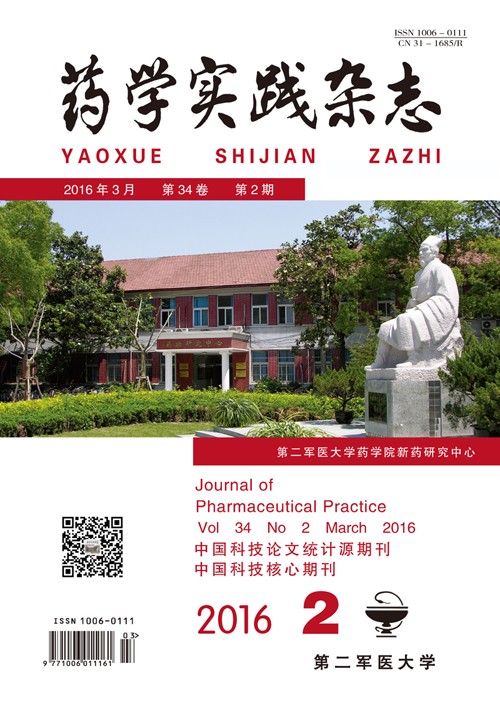|
[1]
|
Lepesheva GI, Waterman MR. Sterol 14alpha-demethylase(cyp51) as a therapeutic target for human trypanosomiasis and leishmaniasis[J]. Curr Top Med Chem, 2011, 11(16):2060-2071. |
|
[2]
|
Yoshida Y. Cytochrome P450 of fungi:primary target for azole antifungal agents[J]. Curr Top Med Mycol, 1988, 2:388-418. |
|
[3]
|
Warrilow AG, Melo N, Martel, CM, et al. Expression, purification, and characterization of Aspergillus fumigatus sterol 14α-demethylase(CYP51) isoenzymes A and B[J]. Antimicrob Agents Chemother, 2010, 54(10):4225-4234. |
|
[4]
|
Lepesheva GI, Waterman MR. Structural basis for conservation in the CYP51 family[J]. Biochim Biophys Acta,2011, 1814(1):88-93. |
|
[5]
|
Sheng CQ, Miao ZY, Ji HT, et al. Three-dimensional model of lanosterol 14α-demethylase from cryptococcus neoformans:active-site characterization and insights into azole binding[J]. Antimicrob Agents Chemother, 2009, 53(8):3487-3495. |
|
[6]
|
Monk BC, Tomasiak TM, Keniya MV, et al. Architecture of a single membrane spanning cytochrome P450 suggests constraints that orient the catalytic domain relative to a bilayer[J]. Proc Natl Acad Sci(USA), 2014, 111(10):3865-3870. |
|
[7]
|
Ji, HT, Zhang WN, Zhou YJ, et al. A three-dimensional model of lanosterol 14α-demethylase of Candida albicans and its interaction with azole antifungal[J]. J Med Chem, 2000, 43(13):2493-2505. |
|
[8]
|
Sheng CQ, Zhang WN, Zhang MY, et al. Homology modeling of lanosterol 14α-demethylase of Candida albicans and Aspergillus fumigatus and insights into the enzymesubstrate interactions[J]. J Biomol Struct Dyn, 2004, 22(1):91-99. |
|
[9]
|
Li X, Vincent M, Andrew SC, et al. Three-dimensional models of wild-type and mutated forms of cytochrome P45014-sterol demethylases from aspergillus fumigatus and Candida albicans provide insights into Posaconazole binding[J]. Antimicrob Agents Chemother, 2004, 48(2):568-574. |
|
[10]
|
Warrilow AG, Parker JE, Kelly DE, et al. Azole affinity of sterol 14-demethylase(CYP51) enzymes from Candida albicans and Homo sapiens[J]. Antimicrob Agents Chemother, 2013, 57(3):1352-1360. |
|
[11]
|
Fan J, Urban M, Parker JE, et al. Characterization of the sterol 14α-demethylases of Fusarium graminearum identifies a novel genus-specific CYP51 function[J]. New Phytol, 2013, 198(3):821-835. |
|
[12]
|
Hawkins NJ, Cools HJ, Sierotzki H, et al. Paralog re-emergence:a novel,historically contingent mechanism in the evolution of antimicrobial resistance[J]. Mol Biol Evol, 2014, 31(7):1793-1802. |
|
[13]
|
Hargrove TY, Wawrzak Z, Lamb DC,et al.Structure-functional characterization of cytochrome P450 sterol 14α-demethylase(CYP51B) from Aspergillus fumigatus and molecular basis for the development of antifungal drugs[J].J Biol Chem, 2015, 290(39):23916-23934. |
|
[14]
|
Cools HJ, Mullins JG, Fraaije BA, et al. Impact of recently emerged sterol 14 alpha-demethylase(CYP51) variants of Mycosphaerella graminicola on azole fungicide sensitivity[J]. Appl Environ Microbiol, 2011, 77(11):3830-3837. |
|
[15]
|
Eddouzi J, Parker JE, Vale-Silva LA, et al. Molecular mechanisms of drug resistance in clinical Candida species isolated from Tunisian hospitals[J].Antimicrob Agents Chemother, 2013, 57(7):3182-3193. |
|
[16]
|
Morio F, Loge C, Besse B, et al. Screening for amino acid substitutions in the Candida albicans Erg11 protein of azole-susceptible and azole-resistant clinical isolates:new substitutions and a review of the literature[J]. Diagn Microbiol Infect Dis, 2010, 66(4):373-384. |
|
[17]
|
Marichal P, Koymans L, Willemsens S, et al. Contribution of mutations in the cytochrome P45014alpha-demethylase(Erg11p, Cyp51p) to azole resistance in Candida albicans[J]. Microbiology, 1999, 145:2701-2713. |
|
[18]
|
Kudo M, Ohi M, Aoyama Y, et al. Effects of Y132H and F145L substitutions on the activity, azole resistance and spectral properties of Candida albicans sterol 14-demethylase P450(CYP51):a live example showing the selection of altered P450 through interaction with environmental compounds[J]. J Biochem, 2005, 137(5):625-632. |
|
[19]
|
Bellamine A, Lepesheva GI, Waterman MR. Fluconazole binding and sterol demethylation in three CYP51 isoforms indicate differences in active site topology[J]. J Lipid Res, 2004, 45(11):2000-2007. |
|
[20]
|
Warrilow AG, Martel CM, Parker JE, et al. Azole binding properties of Candida albicans sterol 14-alpha demethylase(CaCYP51)[J]. Antimicrob Agents Chemother, 2010, 54(10):4235-4245. |
|
[21]
|
Warrilow AG, Mullins JG, Hull CM, et al. S279 point mutations in Candida albicans sterol 14-alpha demethylase(CYP51) reduce in vitro inhibition by fluconazole[J]. Antimicrob Agents Chemother, 2012, 56(4):2099-2107. |
|
[22]
|
Kelly SL, Lamb DC, Loeffler J, et al. The G464S amino acid substitution in Candida albicans sterol 14alpha-demethylase causes fluconazole resistance in the clinic through reduced affinity[J]. Biochem Biophys Res Commun, 1999, 262(1):174-179. |
|
[23]
|
Lamb DC, Kelly DE, White TC, et al. The R467K amino acid substitution in Candida albicans sterol 14alpha-demethylase causes drug resistance through reduced affinity[J]. Antimicrob Agents Chemother, 2000, 44(1):63-67. |
|
[24]
|
Lamb DC, Kelly DE, Schunck WH, et al. The mutation T315A in Candida albicans sterol 14alpha-demethylase causes reduced enzyme activity and fluconazole resistance through reduced affinity[J]. J Biol Chem, 1997, 272(9):5682-5688. |
|
[25]
|
Mellado E, Alcazar FL, Garcia EG, et al. New resistance mechanisms to azole drugs in Aspergillus fumigatus and emergence of antifungal drugs-resistant A. fumigatus atypical strains[J]. Med Mycol, 2006, 44:367-371. |
|
[26]
|
Garcia EG, Mellado E, Gomez-Lopez A, et al. Differences in interactions between azole drugs related to modifications in the 14-alpha sterol demethylase gene(Cyp51A) of Aspergillus fumigatus[J]. Antimicrob Agents Chemother, 2005, 49(5):2119-2121. |
|
[27]
|
Rodriguez-Tudela JL, Alcazar-Fuoli L, Mellado E, et al. Epidemiological cutoffs and cross-resistance to azole drugs in Aspergillus fumigatus[J]. Antimicrob Agents Chemother, 2008, 52(7):2468-2472. |
|
[28]
|
Alcazar-Fuoli L, Mellado E, Cuenca-Estrella M, et al. Probing the role of point mutations in the cyp51A gene from Aspergillus fumigatus in the model yeast Saccharomyces cerevisiae[J]. Med Mycol, 2011, 49(3):276-284. |
|
[29]
|
Rodero L, Mellado E, Rodriguez AC, et al. G484S amino acid substitution in lanosterol 14-alpha demethylase(ERG11) is related to fluconazole resistance in a recurrent Cryptococcus neoformans clinical isolate[J]. Antimicrob Agents Chemother, 2003, 47(11):3653-3656. |
|
[30]
|
Sionov E, Chang YC, Garraffo HM, et al. Identification of a Cryptococcus neoformans cytochrome P450 lanosterol 14alpha-demethylase(Erg11) residue critical for differential susceptibility between fluconazole/voriconazole and itraconazole/posaconazole[J]. Antimicrob Agents Chemother, 2012, 56(3):1162-1169. |







 DownLoad:
DownLoad: